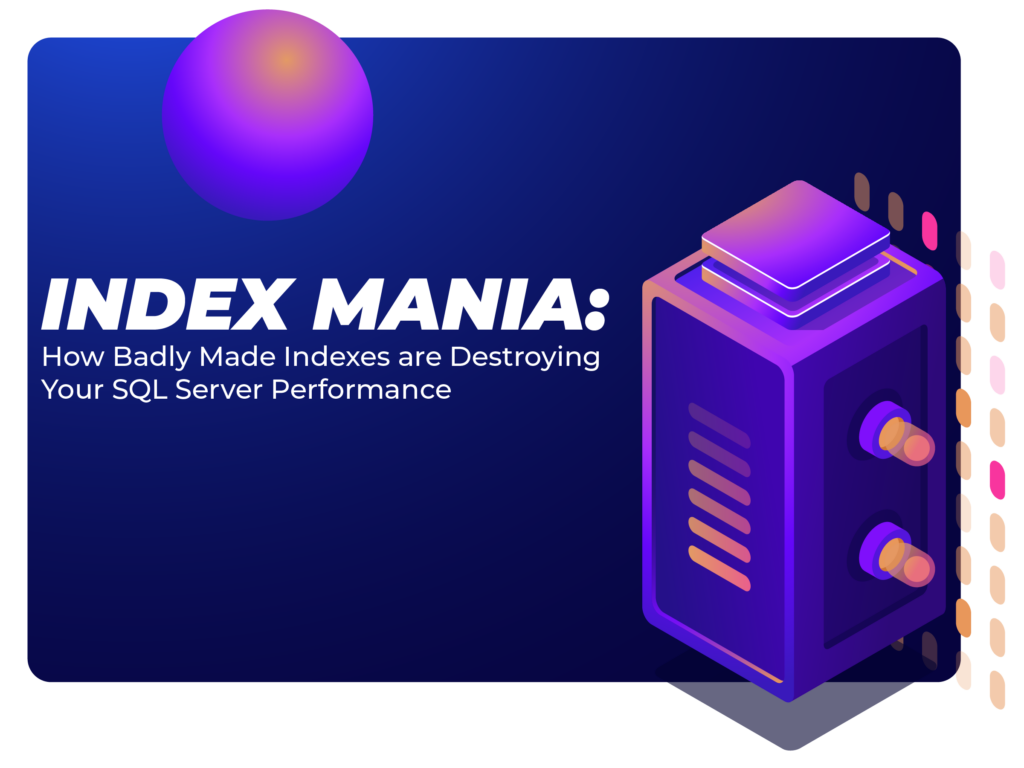

Imagine your SQL Server database as a patient. One day, a specific query becomes slow—a clear symptom. A well-intentioned developer or DBA acts like a doctor and prescribes a “remedy”: a new non-clustered index. The query instantly improves. The treatment was a success. Encouraged, the next time another symptom of slowness appears, the team prescribes another index. And then another. Over time, the patient’s “medicine cabinet” becomes cluttered. The SQL Server now has hundreds, maybe thousands of indexes.
What the team doesn’t realize is that they are no longer treating the disease; they’ve created a new one. The patient now suffers from a chronic condition, an iatrogenic disease caused by overtreatment: Index Mania.
This condition is one of the most insidious and silent causes of performance degradation in SQL Server environments. It doesn’t manifest as an explicit error or a sudden crash. Instead, it acts as a slow poison, making every write operation (INSERT, UPDATE, DELETE) a little slower, inflating cloud storage costs, prolonging backup windows, and, paradoxically, making the query optimizer itself slower.
This article serves as a deep diagnosis of Index Mania, dissecting the different types of toxic indexes, revealing their hidden costs, and presenting the only effective cure: the transition from manual guesswork to continuous and intelligent observability with dbsnOOp.
The Performance Pathogens: Identifying the Types of Problematic Indexes
Index Mania is not caused by a single type of index, but by an infestation of various strains of poorly planned or forgotten indexes. Knowing the enemy is the first step to eradicating it.
Duplicate or Redundant Indexes: The Unnecessary Echo These are the easiest culprits to understand, but surprisingly common. They occur when two or more indexes serve the same purpose.
Classic Scenario: An index exists on the (IDCliente) column. Weeks later, to optimize another query, a developer creates a new index on (IDCliente, DataPedido). The first index became completely redundant. Any search that could use the first one can, even more efficiently, use the second.
The Damage: For every INSERT or UPDATE on the table, SQL Server now needs to maintain two separate B-Trees, doing double the write work for absolutely no read gain. It’s paying for two and getting one.
Unused Indexes: The Zombies of Your Database These are the most dangerous indexes because they are completely invisible to application teams. They do nothing… for reads.
Origin: They were created months or years ago to optimize a report that no longer exists, for an old version of the application, or for a data loading process that has been deactivated.
The Damage: An unused index (user_seeks = 0, user_scans = 0, user_lookups = 0) is pure dead weight. It doesn’t help any query, but it imposes a penalty on every INSERT, UPDATE, and DELETE made on the table, as SQL Server is forced to keep this useless data structure perfectly organized. They consume disk space, memory in the buffer pool, and CPU time, acting like zombies that feed on your server’s resources.
Excessively Wide Indexes: The Unnecessary Baggage An index is not free. Each column added to it increases its size on disk and in memory. “Index Mania” often leads to the creation of gigantic indexes.
Typical Scenario: To avoid a “Key Lookup,” a developer creates an index that includes dozens of columns (INCLUDE) or adds text columns (VARCHAR(MAX)) to the index key.
The Damage: Wide indexes consume a massive amount of space in the buffer pool, the most valuable RAM on SQL Server. This means there is less space for data pages, forcing SQL Server to read more from the disk, which defeats the purpose of the index. It’s like trying to speed up a race car by adding a ton of useless baggage.

The Bill Has Arrived: The Systemic Cost of Excessive Indexing
The real problem with Index Mania is that its costs are not linear. They compound and affect the entire database ecosystem in ways that are not immediately obvious.
Death by a Thousand Cuts: DML Degradation Every INSERT into a table with 20 non-clustered indexes is not a single write operation. It’s 21 writes: one for the table data (the clustered index) and 20 more for each of the non-clustered indexes that need to be updated. This transforms data modification operations, which should be fast, into performance bottlenecks, causing blocking problems and increasing the application’s overall latency.
Storage Bloat and the Cloud Bill In an on-premise environment, the extra space consumed by useless indexes might go unnoticed. In the cloud (AWS, Azure, Google Cloud), this waste has a direct and recurring monthly cost. Gigabytes of duplicate and zombie indexes translate into higher costs for disks (EBS, Premium Disks) and backup snapshots. You are, literally, paying to store useless data.
Endless Backups and Maintenance The size of your database directly affects the time required for critical maintenance operations. Backups take longer. Running DBCC CHECKDB for integrity verification drags on. And, most importantly, index rebuild and reorganization jobs, essential for combating fragmentation, can take hours or even days to complete, forcing longer and riskier maintenance windows.
The Antidote: From Manual Hunting with DMVs to a Cure with dbsnOOp
How to diagnose and cure Index Mania? The traditional approach involves running complex queries on Dynamic Management Views (DMVs), mainly sys.dm_db_index_usage_stats. However, this manual approach is reactive and flawed.
DMV Amnesia: The data in this DMV is zeroed out every time the SQL Server service is restarted. An index that seems “unused” today may be crucial for a report that runs only on the first day of the month. Without a persistent history, the decision to remove an index is a dangerous guessing game.
Complex Analysis: Identifying duplicate or redundant indexes requires scripts that compare the keys and included columns of all indexes on a table, a complex and error-prone task.
dbsnOOp: The Index Diagnosis Specialist dbsnOOp was designed to be the definitive antidote to Index Mania. The platform automates the analysis and provides a clear and continuous diagnosis of the health of your indexing strategy.
Continuous History and Intelligence: Unlike DMVs, dbsnOOp collects and stores the usage history of indexes over time. It understands weekly, monthly, and quarterly usage patterns, ensuring that the recommendation to remove a “zombie index” is based on long-term data, not a volatile snapshot.
Accurate and Actionable Diagnostics: The platform has a dedicated panel that automatically classifies and displays all problematic indexes:
- Unused Indexes: Lists all indexes with zero reads and high write cost, already providing the DROP INDEX script for review.
- Duplicate/Redundant Indexes: Shows exactly which indexes are overlapped and recommends which one can be safely removed, explaining why.
- Expensive Indexes: Identifies the indexes that consume the most resources during DML operations, allowing you to evaluate the cost-benefit of each one.
Don’t let overtreatment become the disease. It’s time to perform a complete check-up on your indexing strategy.
Stop guessing and start optimizing with precision. Schedule a meeting with our specialist or watch a practical demonstration to see how dbsnOOp can cure your environment’s Index Mania.
Schedule a demo here.
Learn more about dbsnOOp!
Learn about database monitoring with advanced tools here.
Visit our YouTube channel to learn about the platform and watch tutorials.

Recommended Reading
- SQL Server Fine-Tuning: As a direct and essential complement to the article’s topic, this guide explores other techniques and strategies to optimize SQL Server performance, offering a broader context where index management fits.
- Db2: Fine-Tuning: Understand the performance optimization practices in another large relational database system. Comparing the approaches can enrich your understanding of universal tuning principles.
- MongoDB Fine-Tuning: Explore the world of optimization in a NoSQL database. Learning how indexing and performance are handled outside the SQL universe can provide new perspectives for solving complex problems.

